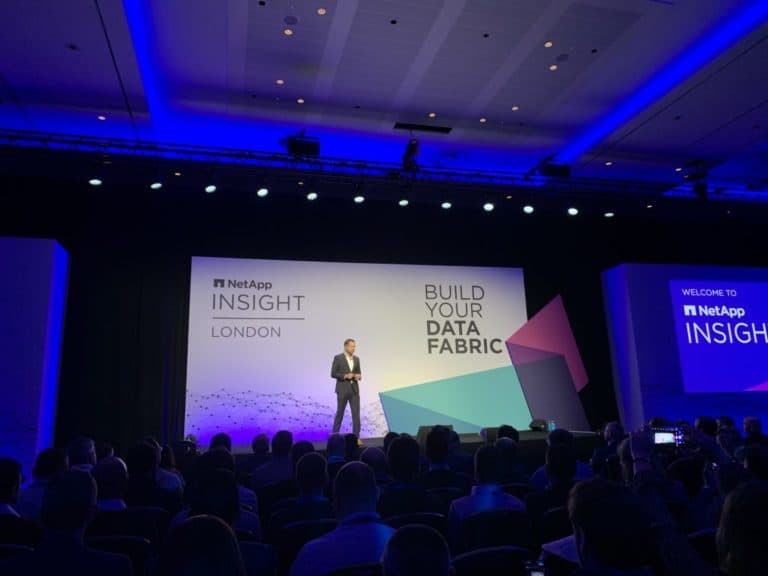NetApp originally specialises in storage, but the image of the IT vendor is changing. It offers more and more services focused on storage and business data. For this purpose, they can set up a complete architecture, which is also called Data Fabric. The idea is to provide a consistent experience between on-premise locations and cloud environments. For NetApp, it’s important to address complex data and storage issues in order to simplify the multi-cloud era.
In recent years, several hardware vendors have made the switch to software. The mass adoption of the cloud contributes to this, among other things. The technology ensures that everything is offered more ‘as-a-Service’, and companies give less priority to physical hardware.
NetApp has been anticipating this for a number of years, as the company made clear during our visit to the Insight conference. It’s looking for a good mix of software, the cloud and hardware. On-premise support remains important in this, as companies are expected to continue to run a lot of applications and data locally. To support this, physical storage products will continue to be made.
During Insight, NetApp showed to be proud of its current mix of data and storage services. According to NetApp, it is even ahead of the competition in several areas.
What does the vision look like at the moment?
At the basis of NetApp’s shift is the so-called Data Fabric. The company introduced this concept to the market a few years ago to tackle data silos. Data is found in more and more places: distributed across different clouds, in the company’s own data center and now more and more often at the edge. As a company, you want to find a uniform approach, so that you can access data anywhere. The Data Fabric architecture tries to realise this uniformity.
NetApp places layers of software across different environments and hardware products, as it were, so that there are no limiting factors. The company thus sees itself as an ‘enabler’ of the hybrid-multi-cloud, with which it actually says that it brings together the best experiences from any environment. Every environment a company uses must be supported. Far-reaching integrations have therefore been set up with the relevant IT suppliers. The cloud providers include AWS, Microsoft Azure, Google Cloud and IBM Cloud, while it can also work with large database and software vendors such as Oracle and SAP.
In a kind of extension of this, NetApp has an HCI solution, which should form a solid basis for the Data Fabric. Although it talks about Hybrid Cloud Infrastructure instead of Hyper-Converged Infrastructure, the functionality is comparable to pure HCI. It concerns a software layer that unites IT resources such as storage and compute. NetApp, therefore, brings the various components together, making workloads easier to move. Everything that runs on-premise, but also in different cloud environments, is easy to manage with HCI.
The all-flash storage arrays form another important component; they should achieve performance and speed improvements over the old NetApp storage products. To make the switch to all-flash, SolidFire was acquired a few years ago for almost a billion dollars. In the meantime, this party has merged into NetApp in such a way that NetApp has become a market leader in the field of all-flash storage in various regions.
New as-a-Service model within the portfolio
Now that the concept has been worked out and companies embrace the working method, NetApp has looked at how it can reach the next phase. The company follows a clear trend within the market, namely the possibility to purchase products based on a consumption model (as-a-Service). The purchase of services based on consumption is becoming more and more a standard within the IT market, so NetApp could not really stay behind. Competitors had previously introduced similar models.
With the new model, which NetApp calls Keystone, companies no longer have to make a one-off payment to purchase a storage product. Instead, they purchase the product based on usage. Once a month, quarter or year you will receive an invoice from NetApp. KeyStone can even be tried on-premise before companies make an investment.
It is the intention that the deployment of the desired resources will also be simplified with the as-a-Service model. Within NetApp this is also described as ‘1, 2, 3 simplicity’, referring to the limited number of steps that are taken. First, a company chooses the performance tier, then the type of data storage (file, block or object) and finally whether the company performs the management itself or whether NetApp does so. According to the storage specialist, this process can be completed within minutes.
This approach also provides users with a more flexible experience and greater freedom of choice. Previously, substantial investments were made, and companies were inclined to stick to the same infrastructure solutions for years. With KeyStone, it should be easier to switch to other solutions, while also making it easier to scale up and down resources.
Simplification is the basis for innovation
NetApp is taking the necessary steps to keep up with today’s IT market. The Data Fabric architecture has been on the market for some time and continues to evolve. The biggest innovation is KeyStone, with which NetApp’s services and products can be purchased on the basis of a consumption model. Competitors were a bit faster with such an as-a-Service model, but that does not make the simplification any less interesting. After all, NetApp has taken a strong position in the data and storage market, as a result of which customers are undoubtedly waiting for the consumption model. Therefore, we are curious to see how the company and its products will develop further in the coming period.
